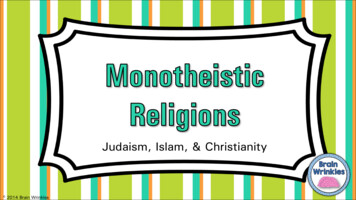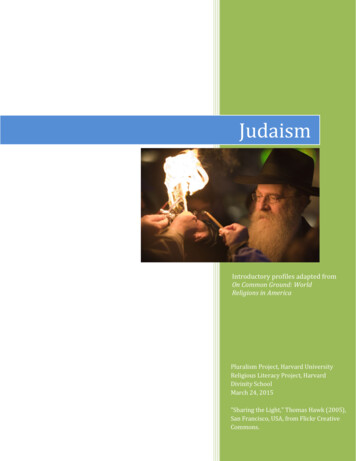
Transcription
JudaismIntroductory profiles adapted fromOn Common Ground: WorldReligions in AmericaPluralism Project, Harvard UniversityReligious Literacy Project, HarvardDivinity SchoolMarch 24, 2015"Sharing the Light," Thomas Hawk (2005),San Francisco, USA, from Flickr CreativeCommons.
Judaism 2015Preface: How to Read These ProfilesIn these religion profiles, our focus is on particularreligious traditions with an emphasis on 1) theirinternal diversity, and 2) the ways that the traditionsare always evolving and changing. Though we hopethese profiles provide helpful introductions, this formatis a bit misleading in that it can reinforce the idea thatreligions exist and develop in isolation from other socialand historical forces, including other religions. Whilereading these profiles, please remember that religionsalways impact and are impacted by political, economic,social, and historical factors. Please see the Methodsarticle for fuller explanation of these intersections andthe Country Profiles for a demonstration of how tounderstand religious influences in particular social andhistorical contexts.God, Torah, and IsraelContentsPreface: How to Read These ProfilesGod, Torah, and IsraelGod: Biblical MonotheismIsrael: Jewish NationhoodPost-Biblical ReligionRabbinic TextDiaspora Community10112579Kabbalah and Hasidism12Zionism and Israel15Modern Jewish CultureAnti-Semitism and the Holocaust1317Religion profiles are adapted from OnCommon Ground: World Religions in America,a resource of the Pluralism Project(www.pluralism.org/ocg).The Pluralism Project at HarvardUniversityThe Religious Literacy Project at HarvardDivinity School"Star of David" by Knokton (2010) at FlickrCreative Commons.Simply put, Judaism is the way of life of the Jewishpeople. In the English-speaking Western world,“Judaism” is often considered a “religion," but there areno equivalent words for “Judaism” or for “religion” inHebrew; there are words for “faith,” “law,” or “custom”but not for “religion” if one thinks of the term asmeaning solely the beliefs and practices associated witha relationship with God or a vision of transcendence.The Jewish tradition is much broader than this. As a wayof life, it includes the social, cultural, and religioushistory of a widespread and diverse community,including people who do and do not think of themselvesas “religious.”Judaism embraces the intricate religious and culturaldevelopment of the Jewish people through more thanthirty centuries of history, stretching from Biblical timesto medieval Spain to the Enlightenment, and then to theHolocaust and the founding of the modern state ofIsrael. The result is an experience that reflects theelliptical relationship between religious practice andpeoplehood. From a religious perspective Judaism is atheistic system, but from a peoplehood perspective, it isalso the group memory of the manifold communitiesand cultures formed by Jews through the ages. Itconsists not only of Torah (divine revelation)Adapted from On Common Ground (www.pluralism.org/judaism)
Judaism 2015and mitzvoth (divine commandments), but also the diverse cultures of the Hebrew, Yiddish, and Ladinolanguages. It includes not only the visible markers of religious observance, such as the kippah or thepayot or the tzitzit, but also the communal structures of the kehillah, the mellah, and the shtetl. Itincludes politics—whether in Poland, America, or Israel. And it includes the whole range of Jewisheducation and family life, food and festival, music and dance, and custom and humor.Judaism is perhaps best conceptualized as a triad with three points ofreference: God, Torah, and the people of Israel (that is, the Jewishpeople). None is central; all are interdependent, with varying degrees ofemphasis at various times. God is the God of Israel, the God of allcreation, the one God. Torah embodies Judaism’s intellectual culture,focusing on the study, understanding, and interpretation of sacred texts.Israel focuses on Judaism as a historical culture and the civilization of aparticular people; the “peoplehood” of the Jews includes customs andfoods, arts and music, dance and folkways that are part of a way of life.Judaism is critically concerned with the evolving relationship betweenGod, Torah, and the Jewish people, a relationship described as acovenant. In the covenantal triad, God emphasizes the verticalrelationship of the Jewish people to the Divine; Israel emphasizes thehorizontal relationship Jews bear to one another, and Torah is bothvertical and horizontal, for it defines the way of life of a whole peoplelived in relationship to God.These three connotations of Judaism as a monotheistic system, as aliterary tradition, and as a historical culture are sometimes viewedseparately. For example, there are Jews who see themselves as culturallyJewish, but who are also non-religious or atheist, often identifying morestrongly with Jewish “peoplehood” than with traditional understandings of God and Torah. Even so, allJews would recognize that these three points of reference have shaped and guided Jewish experiencethrough the ages.A girl carries a covered Torah,USCJ.Program.Pix (2007), FlickrCreative Commons.The great symbols of God, Torah, and Israel have assumed varying positions of prominence throughoutJewish history, and our discussion of them necessarily unfolds within an ongoing historical framework.Such a historical approach is critical for an understanding of contemporary Judaism, for Judaism is ahistorical tradition—in which history is valued in and of itself. In many ways, Judaism has always beenthe sum total of all the history of its God, texts, and people.God: Biblical MonotheismThe vision of a universal, singular God is arguably one of the greatest religious innovations of theJewish tradition among the world’s historic religious systems. Between 1500 and 500 BCE, theIsraelite people of the ancient Near East began to articulate a radical new understanding of divinity.The ancient Hebrews were most likely “polytheistic,” believing in numerous deities representingdifferent forces of nature and serving various tribes and nations. Eventually, however, early Hebrewvisionaries and prophets began to speak boldly of one God as the creator of all existence, a view wehave come to call “monotheism.” Expressing the multivalent nature of divinity as well as an insistenceAdapted from On Common Ground (www.pluralism.org/judaism)
Judaism 2015upon the oneness of God, early Hebrew authors gave God names such as Elohim (“gods”), Adonai (“mylord”), and the unpronounceable YHWH, from the same root as the verb "to be," the etymologicalsource of the name “Jehovah."Through the visions and the voices of prophets, the God the Hebrews encountered was all-powerfuland benevolent, merciful and just. Rejecting the anthropomorphic tendency of the time, the Hebrewsdid not represent God in any human form or earthly likeness, but as a universal God, engaged in alasting relationship with humankind through the instruments of revelation, Torah, and a covenantalpeople, Israel. This emerging understanding of God would have profound implications for the historyof Western religion.A photography of Yemenite Jews in Jerusalem taken bymissionaries between 1898 and 1911. PalestineExploration Fund, Flickr Creative Commons.Geographical context, of course, was essential to thedevelopment of ancient Israelite monotheism. Living in theland of Canaan, situated midway between the civilizationsof Mesopotamia and Egypt at the heart of the FertileCrescent, the ancient Hebrews were exposed to thereligious cultures of multiple world powers. WhileMesopotamian deities, represented in the form of images,were numerous, Mesopotamian society was ordered by apermanent set of laws—the Code of Hammurabi—and notsubject to the capriciousness of their many gods.Meanwhile, Egyptian religion posited an unchanging set ofnature deities represented on earth by a divine ruler, thePharaoh. The Hebrews, originating in Mesopotamia andenslaved for generations in Egypt, adopted elements ofboth world views. They rejected the idol worship ofMesopotamian religion while preserving the rational andjust organization of its society, and rejected the humandeification of the Egyptian Pharaoh while preserving thesingularity of his rule: God alone is sovereign. Throughnegotiating the polytheism and idolatry of religiouscultures at the time, the Hebrew concept of God drew inlarge part from the Israelites’ Near Eastern neighbors.Despite these continuities, there was something quite new in the Hebrews’ understanding of God.Unlike the Mesopotamians or the Egyptians, the ancient Hebrews affirmed that their laws camedirectly from God. For example, God’s gift of the Torah on Mount Sinai became pivotal in the Hebrewpeople’s self-understanding. God was not an abstract concept or principle, but actively involved inhistory through revelation and covenant. Throughout Jewish history, the common thread has beenGod’s relationship with humanity. Every Jewish theological concept of God has implications for thenature of human existence: God’s creation of the universe, including the possibilities of good and evil,implies the existence of human free will and leads ultimately to a belief in human freedom and dignity.At the same time, God’s covenant with the Jewish people and involvement in human history impliesthat individuals and societies exist for a reason, unfolding along a purposeful plan.Adapted from On Common Ground (www.pluralism.org/judaism)
Judaism 2015These themes, initially developed through oral literature, were soon compiled into the written recordof the Hebrew Scriptures. Jews today continue to pride themselves on the fact that the "ethicalmonotheism" of Judaism is the basic building block of Western religion. The idea of one God unitesbroad human communities historically, religiously, and culturally to the present day.Torah: Covenant and ConstitutionTorah is the one Hebrew word that may provide the best lens into the Jewish tradition. Meaningliterally “instruction” or “guidebook,” the Torah is the central text of Judaism. It refers specifically tothe five books of the Bible called the Pentateuch, traditionally thought to be penned by the earlyHebrew prophet Moses. More generally, however, Torah applies to all of Jewish sacred literature,learning, and law. It is the Jewish way.According to the Jewish rabbinic tradition, theTorah in its broadest representation is God’sblueprint for the creation of the universe. Morespecifically, the Torah is also the constitution of theJewish people, the historical record of origins andthe basic legal document passed down from theancient Israelites to the present day. Torah providesthe basis for the Jews' relationship to God as well astheir interactions as a socio-political cultural group.First recorded as an oral tradition and written infragments, the Hebrew text of the five books of the"Nehar Shalom Community Synagogue Torah," Steve GarfieldTorah was edited over a period of centuries(2008), Flickr Creative Commons.(generally thought to be from 1000 to 500 BCE),and canonized in its final form during subsequentgenerations. The first book, Bereshit, comes from the opening words of the text, “In the beginning.” Alater Latin translation called it Genesis. This collection of texts contains the story of God’s creation ofthe world, the story of human origins, and the patriarchal narratives that comprise the story of Jewishorigins. The subsequent four books are Shemot (“Names” or Exodus), Vayikrah (“And God called” orLeviticus), Bamidbar (“In the desert” or Numbers), and Devarim (“Words” or Deuteronomy). Thesebooks recount the story of the Jews' enslavement in Egypt, their liberation from Egypt under Moses,their sojourn in the desert, and their eventual return to the promised land, the land of Canaan.The central event of these narratives, the climactic moment in biblical history, is God’s gift of the Torahto the Jewish people at Mount Sinai. Besides containing the history of God’s relation with Israel, thesefive books are interspersed with 613 divine laws (mitzvot, meaning “commandments”). This divine lawinforms both ethical and ritual behavior, forming the basis of all subsequent Jewish law.In addition to the five books of the Torah, the Hebrew Bible contains two more collections, Nevi’im(“Prophets”) and Ketuvim (“Writings”). Prophets consists of ten books, beginning with the historicalnarratives of Joshua, Judges, Samuel I-II, and Kings I-II, and concluding with the prophetic oracles ofIsaiah, Jeremiah, Ezekiel, and a book of twelve minor prophets. These works span seven centuries,from the conquest of Canaan (c. 1250-1200 BCE) to the exile of the Jewish people to Babylon in theAdapted from On Common Ground (www.pluralism.org/judaism)
Judaism 2015sixth century BCE. The nine books of various genres which make up Writings are Psalms, Proverbs,Job, Megillot (the scrolls containing Song of Songs, Ruth, Lamentations, Ecclesiastes, and Esther),Daniel, Ezra, Nehemiah, and Chronicles I-II. In addition to its poetic and wisdom literature, Writingsbring the history of the Jewish people into the fifth century BCE, the period of restoration, when theJews returned to Jerusalem after their exile in Babylon. The Torah, Nevi’im, and Ketuvim togethercomprise the Hebrew Scriptures, known by its Hebrew acronym Tanakh. With some revisions andrearrangements, the Tanakh was translated into Greek to become the Septuagint, the basis of theChristian “Old Testament.” It is important to note that the Tanakh and the Old Testament are twodifferent books with slight differences between them, primarily in the order and emphasis of the texts.After the final compilation of the Torah, the book of Ezranotes that the first public reading of the text took place in444 BCE, when Ezra the Scribe instituted the practice inJerusalem. He also initiated a professional class ofspecialists in the transcription, illumination, andinstruction of Torah. During the Roman Empire, thesemaster teachers, now known as “rabbis,” became theleaders of the Jewish community, and their seat ofreligious learning, the yeshiva, became a centralinstitution of Jewish life. Jews have been reading,studying, and interpreting the text of the Torah eversince.In Jewish communal worship today, the weekly Torahreading is the heart of the synagogue service. The scrolls An Ethiopian Falasha Rabbi holds a Torah, Beanyof the Torah are kept in the holy ark, often covered with Wezelman (1966), The Magnes Collection of Jewish Artand Life, Flickr Creative Commons.velvet, and when they are taken out to be read, they arelifted for all to see, carried with joy and reverencethrough the congregation, placed upon the reader’s desk, and unrolled. Then weekly Torah portionsare read by members of the congregation. Outside the synagogue, Torah study is an important activityof the Jewish school and home. Since it is considered by most religious Jews as the direct utterance ofGod and therefore sacred, study is as important as worship. For some Jews in the modern world, thiscommitment to study becomes pride in the vitality of intellectual life.Israel: Jewish NationhoodFrom the perspective of Jewish tradition, all Jews share a common ancestry descended from Abrahamand his wife Sarah, and are therefore part of the same extended family. The Torah attributes thiscommonality to the patriarch Abraham: in his covenant with God, Abraham was promised that hewould become the father of a great nation. Fulfilling the promise, they had a son, Isaac, whose own sonJacob was renamed Israel, literally “the one who struggles with God” (Genesis 32:29). Israel is thename of a person, a people, and a land.The patriarch Jacob, renamed Israel, fathered twelve sons, the progenitors of the historic twelve tribes.First, they were known as bnei yisrael (“the children of Israel”). To this day, members of the Jewishcommunity describe themselves metaphorically as a “tribe” and “family.” Second, the children of IsraelAdapted from On Common Ground (www.pluralism.org/judaism)
Judaism 2015(bnei yisrael) became the nation of Israel (am israel), following their liberation from slavery in Egyptand the uniting of the Israelite clans by the decree of God. Third and finally, the pivotal stage in thebiblical account of nation-building was the inheritance of the promised land of Canaan, whichthereafter became known as eretz yisrael, the land of Israel.From a historical perspective, however, it may be more appropriate to highlight the transformation ofthe Jewish people from a loose confederation of tribes into a unified nation in the period of theIsraelite monarchy, beginning in the late eleventh century BCE. After a period of political and socialflux, King David (c. 1000-960 BCE) united the kingdom of Israel around his capital city of Jerusalem.David’s son Solomon (c. 961-922 BCE) built a Holy Temple in Jerusalem, thereby unifying the ritualsand worship of the Israelite tribes as well. Following Solomon’s death, however, his warring sonsdivided the kingdom between the northern Kingdom of Israel and the southern Kingdom of Judah.In 722 BCE, the Kingdom of Israel was conquered by the Assyrians and its population deported. Thesewere called the ten “lost” tribes (“lost” to the rest of the Israelite world). While tragic, the Assyrianconquest helped solidify those who remained into a more cohesive Israelite polity. The subsequent fallof the Kingdom of Judah (“Yehudah” in Hebrew, or “Judea”) similarly encouraged the survivingIsraelites to develop a stronger, more cogent sense of identity in the face of violence and deportation.This identity would soon face a severe challenge. In the year 586 BCE, the Babylonians conqueredJerusalem, destroyed the holy Temple, and exiled the majority of the population. In exile, the Israelitepeople responded by developing a sense of unity transcending geopolitical divisions (i.e., a strongsense of peoplehood). Israelite religious leaders of this period drew upon their situation to expressmuch of the writings of the Tanakh, transforming their socio-political context in exile in Babylon intonarratives of Israelite trials in slavery, oppression, and politics. It was during the period of theBabylonian exile, which lasted several decades, that the Israelites first came to be called Judeans(“Yehudim” in Hebrew, the etymological root of the words “Judaism” and “Jewish”).Amulets attached to a headband worn during circumcisionrituals in Tunisia, 1983. The Magnes Collection of JewishArt and Life, Flickr Creative Commons.Therefore, from both traditional and historicalperspectives, the bond of peoplehood has informedJewish identity throughout the centuries. The familialelement has remained strong, emphasizing birth as one’sentrance into the Jewish community. A Jew is defined bysome Jewish laws as someone born of a Jewish mother;though the principle of matrilineal descent has beenchallenged in recent decades, the notion that Jewishnessderives from family background forms a key componentin the Jewish self-image. Conversion to Judaism ispossible, but the concept of family heritage remainsparamount: the convert is welcomed as a new, adoptedmember of the family. The male convert reenactsAbraham’s covenant for men, including the b'ritmilah (the covenant of circumcision), and is thusconsidered to have joined the people, not simply adoptedthe religion. Meanwhile, a female convert will beAdapted from On Common Ground (www.pluralism.org/judaism)
Judaism 2015regarded as the mother of Jewish children. King David himself was the product of such foreign lineage,having descended from the convert Ruth.Post-Biblical ReligionWhen the nascent Jewish community returned from exile in Babylon circa 515 BCE, the Temple wasrebuilt and rededicated. The Second Temple stood for approximately 500 years. During the SecondTemple period, the religious practices that emerged during earlier Israelite Biblical history(particularly the Israelites’ slavery in Egypt, kingship in Israel and Judah, and conquest and exile by theAssyrians and Babylonians) became further developed and refined into a more formal, post-BiblicalJewish identity. The development of what we know as Judaism today took place late in this period, asthe religious leadership of the rabbis emerged.After the destruction of the Second Temple by theRomans in the year 70 CE and during the subsequentexile of the Jews from the land of Israel once again, therabbis confirmed and remodeled Jewish practice intosome of the systems more contemporary Jews mayrecognize today. Translating the laws of the Torah intoa new cultural language, the rabbis established acomprehensive ethical system that ordered the entirelife of the Jewish people. Rabbinic Judaism is thereforebuilt upon the Torah’s commandments (mitzvot in theplural and mitzvah in the singular), encouraging Jewsto serve God in manifold ways both ritual and ethical.The mitzvot concern both one’s relationship with Godand with other people. As one of the early rabbis put it:“The entire world stands on three things: the Torah,the service of God, and acts of loving kindness" (PirkeiAvot [Ethics of the Fathers] 1:2).The rabbis were deeply concerned with ethics andmorality, drawing on the dictates of Torah and itsprophetic calls for justice. An entire tractate of oralTorah tradition, the Mishnah, is devoted to rabbinic“Jews Praying in the Synagogue on Yom Kippur," Maurycyethics. When Rabbi Hillel was asked to summarize the Gottlieb (1877), Wikimedia Commons.Torah, he wrote: “Whatever is hateful to you, do not doto your neighbor. That is the entire Torah. The rest is commentary. Now go and study.” This famousadvice, preserved in the Babylonian Talmud, invokes the Biblical exhortation “to love your neighbor asyourself” (Leviticus 19:18).As a whole, the great religious innovation of the rabbis was to adapt the divine service of thepriesthood for the use of the entire people, thereby democratizing the obligations and the experienceof a life of holiness. By transforming Biblical precedents into a practical religiosity, the early rabbissucceeded in transferring the locus of Jewish religion from the Temple in Jerusalem into the synagogueand home. For a community frequently in exile around the world, even into the twenty-first century,Adapted from On Common Ground (www.pluralism.org/judaism)
Judaism 2015Jewish holy time and space does not require the Temple itself, but exists in the framework of theshul (the Yiddish word for synagogue) and the observant Jewish home.Interior painting of a synagogue in Isfahan, Iran. Horizon(2006), Flickr Creative Commons.Given that a major contribution of the rabbis was toreconstruct Judaism and enable Jewish worship withoutits central Temple, a new institution was developed totake the Temple’s place: the synagogue (bet knesset, or“house of assembly”). As a decentralized house of Godopen to all the people, the synagogue was a radicalinnovation in the history of religions, and eventuallyserved as the model for both the Christian church andthe Islamic mosque. Synagogues first arose in the JewishDiaspora prior to the first destruction of the Temple andemerged as the main institution of Jewish life during theRabbinic era. The synagogue’s earliest function was as ameeting hall for the teaching of Torah, but the rabbisalso developed the space for public worship and liturgy.As the synagogue replaced the Temple, the prayerservice came to replace the sacrificial service of theTemple, both conceptualized as offerings to God.Likewise, the holy space of the Temple was also replaced by the yearly cycle of Jewish holidays and theJewish emphasis on sacred time. The major holidays during the Temple period were the threepilgrimage festivals of Sukkot, Pesach (“Passover”), and Shavuot. All originated as agricultural festivals,later reinterpreted to commemorate the liberation from slavery in Egypt (Sukkot and Pesach) and thereceiving of the Torah at Sinai (Shavuot). Having lost the rituals of pilgrimage and sacrifice when theTemple was destroyed, the rabbis reimagined these observances for the synagogue and home. ForSukkot, they adopted and reinterpreted the folk custom of building outdoor huts, recalling the sojournof the people of Israel in the wilderness after their exodus from Egypt. For Pesach, they formalized thefamily feast to include a ritual retelling of the Exodus story in the Passover seder. Other holidays soonbecame centered in the synagogue and home: the new year cycle of Rosh Hashanah, Yom Kippur,Sukkot, and Simchat Torah were all givenextensive liturgical treatment. Rabbisdeveloped additional holidays based on laterhistorical experiences of the people of Israel:Purim celebrated the legendary rescue ofPersian Jewry from destruction as describedin the Book of Esther. Hanukkah was createdto commemorate the victory of the Maccabeesover the Hellenists in the second century BCE.In these cases, the rabbis gave new spiritualmeaning to already popular celebrations,turning merrymaking into the sacredfulfillment of mitzvot.A Yemenite Jewish Seder in Tel Aviv, Israel. Kluger Zoltan (1946),Government Press Office, Flickr Creative Commons.Adapted from On Common Ground (www.pluralism.org/judaism)
Judaism 2015The mitzvah of Shabbat (keeping holy the Sabbath or seventh day of the week) is an expression of boththe sacrality of the Jewish home and synagogue as well as the significance of Jewish holidays and time.The weekly holy day of rest expresses the distinction between holy and profane. Building upon theBiblical injunction of Exodus 20:8 to “remember the Sabbath day to keep it holy,” the rabbis institutedan elaborate set of laws designed to emphasize the separateness between the Sabbath (a day ofspiritual reflection) and the rest of the working week. To highlight the holiness of the day, rabbinicalauthorities adapted the priestly prohibitions against doing certain kinds of work during the building ofthe Temple. On Shabbat, therefore, the most observant religious Jews refrain from traveling longdistances, carrying large items, lighting fires (or today, using electricity), creating anything tangible, ordoing any number of other mundane tasks. The day is marked by special synagogue services, thepublic reading of the Torah portion, independent Torah study, and family meals.Rabbinic TextTraditionally, Judaism today is conceived as a timeless and ongoing conversation between the Jewsand God, based on centuries of religious development and voluminous writings. These legal andinterpretative texts, arguably the sum total of the discussion, argumentation, and writings of rabbisthrough the ages, is commonly called “rabbinic” literature. Rabbinic literature is a religious textualcompendium developed over the history of the Jewish people, particularly in the Second Templeperiod and afterward.The rabbis designated their literature the Oral Torah, as opposed tothe finalized canon of the Written Torah. While the Torah refersmainly to the five books of Moses, it also refers more widely to all ofJewish sacred literature. To ensure the durability and relevance ofthe Biblical tradition, rabbis drew a distinction between the writtenTorah dictated by God to Moses on Mount Sinai and the unwrittenTorah dictated by God to Moses verbally. According to rabbinictradition, this second tradition was passed down orally, eventuallydeveloped in writing by the rabbis of the third century CE inPalestine and becoming known as the Mishnah.Thought to be modeled on the curriculum of the postTemple yeshiva (a school for rabbinic study), the Mishnah is the basiccode of post-biblical Jewish law. The text’s many sections concern thewhole spectrum of individual and community life—laws ofagriculture, prayers and benedictions, the observances of Sabbathand holidays, women and family law, property, inheritance, andcriminal law, sacred things associated with the Temple, and ritualpurity and impurity.Rabbi Capers Funnye, an AfricanAmerican convert to Judaism, visits withEthiopian Jewish children in Israel(2009), the Jewish Agency for Israel,Flickr Creative Commons.During the third to sixth centuries, the rabbis of the yeshivas inPalestine and Babylonia continued to study and debate the rulings ofthe Mishnah. Their deeply analytical discussions in the Aramaic vernacular of the day were preservedin the Gemarah (an elaboration of, or commentary on, the Mishnah). As a pair, the Mishnah and theGemarah form the Talmud, of which there are two extant versions. The Palestinian Talmud wasAdapted from On Common Ground (www.pluralism.org/judaism)
Judaism 2015finished in the early fifth century; the lengthier and more authoritative Babylonian Talmud wascompleted by the beginning of the sixth.In addition to the Mishnah and the Gemarah, the Talmud contains material that could better be calledfolklore, history, ethics and philosophy. This is collectively called aggadah (or haggadah), constitutingapproximately one-third of the Babylonian Talmud. The rabbis also wrote complete works of biblicalinterpretation called midrash. The whole of the Talmud (the Mishnah and the Gemarah, as well as all ofthe Talmud’s later appendices and elaborations) forms the bulk of rabbinic literature, or “oral Torah.”This living tradition of scripture guaranteed the permanent relevance of the Torah and preserved theimportance of the rabbi’s role as scholar and interpreter of a living tradition for each generation.Rabbinic commentary on both the Torah and the Talmud continued throughout the centuries, andcame to be incorporated into the study of the text.Perhaps the most important legacy of the rabbis is the tradition of lifelong study. As the rabbisintended, the study of Torah and the Talmud are ongoing enterprises. Through study, debate,discussion, and appropriation by each generation, Judaism is indeed a living tradition.Diaspora CommunityGalut is the Hebrew word for “exile,” and refers to the rep
fragments, the Hebrew text of the five books of the Torah was edited over a period of centuries (generally thought to be from 1000 to 500 BCE), and canonized in its final form during subsequent generations. The first book, Bereshit, comes from the opening words of the text, “In the
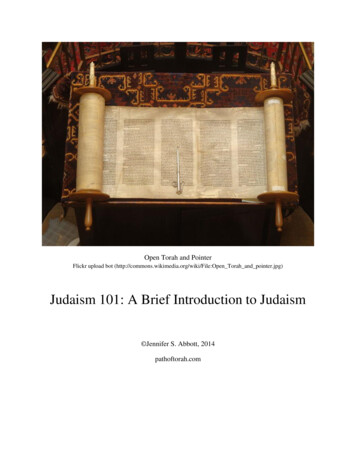
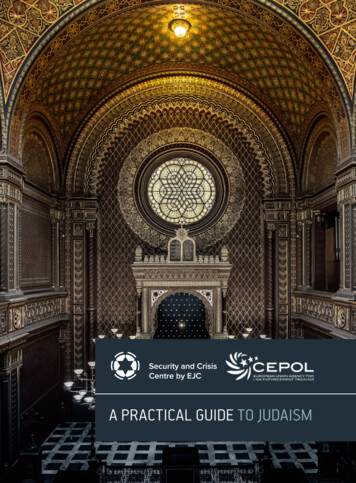
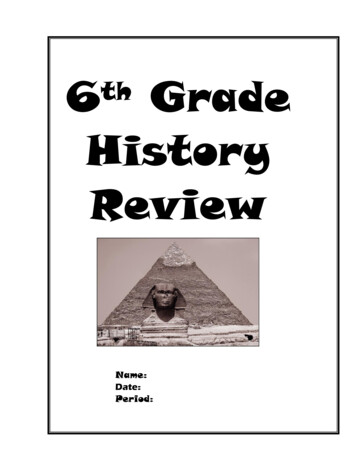
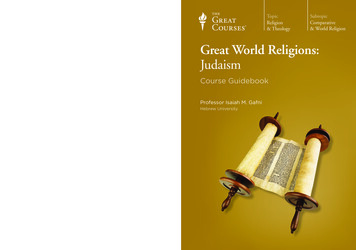

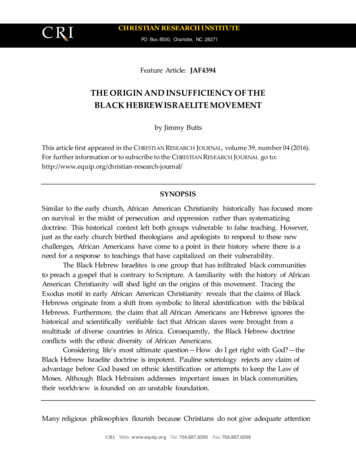
![[Goodman Martin] Judaism in the Roman World](/img/16/goodman-2007.jpg)



